Jeffrey Henning
A Thousand Ways to Say Hello
Tony Chapman of Capital C kicked off the 9th annual ESOMAR online conference, ESOMAR 3D Digital Dimensions, in Boston this morning. “Engagement is the oxygen of marketing to humanity — only through our ability to engage do we have an ability to persuade.”
Mike Cooke, Chair of the 3D Programme Committee, introduced Tony with a T.E Lawrence quote, “All men dream, but not equally. Those who dream by night in the dusty recesses of their minds, wake in the day to find that it was vanity: but the dreamers of the day are dangerous men, for they may act on their dreams with open eyes, to make them possible.”
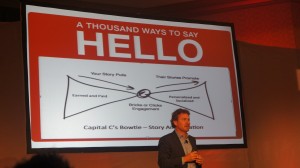 Tony began by discussing the role of storytelling, quoting from Chuck Yeager in his biography on the day he broke the sound barrier. “The faster I got, the smoother the flight… The barriers had never been in the sky, but in our minds.” Tony said, “Storytelling comes down to head, heart and hands.” Can you connect during business meetings? Did people understand what you said? Were they leaning forward? Were they engaged? Did they own your call to action?
Tony began by discussing the role of storytelling, quoting from Chuck Yeager in his biography on the day he broke the sound barrier. “The faster I got, the smoother the flight… The barriers had never been in the sky, but in our minds.” Tony said, “Storytelling comes down to head, heart and hands.” Can you connect during business meetings? Did people understand what you said? Were they leaning forward? Were they engaged? Did they own your call to action?
“Forces of change are rendering obsolete conventional go-to-business strategies to reach consumers,” said Tony. Consumers are changing in many ways. Data is so important to consumers now that they measure calories in, calories out. They research every point. Those who play video games learn with cognitive learning failure — failing, failing, failing, failing, succeed — the same as we did as hunters (18% of gamers feel life in the gaming world is more rewarding than their real life).
Consumers want to know where their products are going and what the differences are. If there aren’t any differences, then Amazon is the world’s largest vending machine, and they will buy the cheapest alternative from Amazon. Capitalism used to be faster, better, cheaper — all a company had to do was excel at one to be successful. Now all three are just table stakes. Business life cycles are shorter: the average small business has a lifespan of just 3,000 days, the Fortune 500 lasts 15,000 days. As a result, procurement has become king, and organizations are challenged to get every working dollar.
Similarly for consumers. “The new reality is we are seeing a flight to price. There is margin compression unlike anything that we have experienced. The only tie breaker we are seeing is price”. All the dollars available are going to go into selling products for less.
“My hypothesis,” said Tony, “is to create the story that sells to consumers’ head, hearts and hand. It is about the nuggets and the insights. Ultimately, we have to change consumers’ thinking, feeling and behaving.” Stories are a way to achieve this. “When you pitch a story for Hollywood it is a hook, for marketing it is an insight. Tell the story with conviction on exactly where the consumer is right now and animate the desired outcome. Understand the challenges the consumer faces.”
The problem in marketing up until four years ago was to spend money. Suddenly over night you are now hired to invest those dollars. The psychology of marketing is shifted. There is such a flight to certainty and safety that brands are drowning in line extensions and safe bets.
Look for differentiation — whether it is Trader Joe’s turning grocery shopping into an adventure, Evian repositioning as as brand of youth and health, or Nike unlocking the inner athlete uy supporting missions and leaderboards where people track their use of Nike products (i.e., workouts). If your story pulls attention from consumers, then their stories about your narrative will promote your brand: transform your earned and paid media into personalized and socialized media. “I don’t want a research company that tells me people like natural spring water or glass bottles. I want a research company that tells me people want to chase the fountain of youth, then I want a research company to identify the places where that message needs to be.”
“The magic of this industry in terms of the value add that you can bring is to moving from providing goods and services to enabling lives and livelihoods,” Tony said. “Instead of providing research, driven by price, be in the business of enabling the livelihood of business, be the lifeblood of decision making for businesses.”
The Future Foundation Digital Download – The latest and greatest in the world of digital
Hyperindividualism, the Performative Self and the Smart Networker
Richard Nicholls of the Future Foundation provided an update on quantitative research into how the digital world influences consumer behavior today. Then he discussed three trends: the hyper individual, the performative self, and the smart networker.
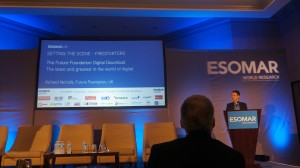
Some findings:
* Rapid growth in smart phones around the world though still under half in most countieis
* Fewer than 20% of consumers have bought a product or service using their mobile phone
* Over 60% of adults using social networking in many developed countries
The hyper individual is how netizens are using digital tools to professionalize their lives. It is the intersection of three trends: maximizing return on purchases, ending inefficiency, and the Quantified Self (tracking health, home energy use, finances and other personal data). The hyper individual uses all these trends — using online tools for price comparison (more likely to be done with computers than smart phones today). While maximizing is a rational behavior, it can become a poor strategy if overdone, if too much time is spent on it. This is where ending inefficiency is important, trusting algorithms to make good decisions on your behalf. Learning and applying methods of self monitoring to professionalize our everyday lives gives rise to the Quantified Self. While just 10% of consumers in the US track spending daily, 32% in South Korea, the Future Foundation expects this to increase dramatically. Consumers will use data to professionalize their lives.
The performative self trend is about social media powering a culture of sharing and recognition. Social networks create a culture of “play and display”, driven by recognition culture, with people finding self-validation in the approval of their posts by others. For instance, Tweet Seat provides theater-goers a discount for live-tweeting during performances. More and more areas of consumer lives will become performative — from recommendations of products to promoting fashion, media, work, ethics, and health. Social extroversion motivates certain types of behavior and consumption.
Finally, the third trend, the smart networker is a growing awareness of managing personal data online. More people are de-tagging photos of themselves on social networking and setting up restrictions to limit who can see profiles. Across the global sample surveyed by Future Foundation, 40% of employed respondents use professional networking sites. More and more, consumers want added control over the personal information they provide companies.
What are the implications of these trends? The hyper individual will professionalize more aspects of their personal lives. The performative self will lead to an increase in the quality of information that consumers choose to share. And the smart networker will expect transactional benefits from data exchange.
By Erika Harriford-McLaren
Digital Research Practices from 500,000 Marketers – Why some marketers succeed with analytics
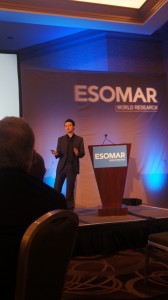
With all the data flooding around us, it seems only logical that marketers would be tapping deep into this with the plethora of tools at hand for analytics. However, Ilya Lichtenstein of MixRank, USA showed us that this isn’t really the case. Through the use of datamining, he identified the technologies and vendors that public, private and advertising companies are using are used for data collection to understand, in real time with accuracy, what they are doing with their marketing. While the use of real time computing analytics is seemingly being used a lot – when MixRank examined use over a 6 month period they discovered that one third of major brands using of these analytics actually declined.
This is troubling seeing that recent surveys show that 90% of marketers have gaps in their customer information, yet are not using the tools (or maybe even the agencies) they could to help them in these areas. In the end, Ilya found that marketers are tracking conversions but not engagement. As this conference highlights, it not just about conversion of numbers but engagement of the consumer on a level and in a platform that they understand and want. We need to understand the connection between marketing actions and how it results in usage and sharing and must remember that it is not just about traffic. And this is where research comes into play…we can make data actionable. We have plenty of it and can process it, but if we are not acting on it, then it is meaningless in the end and just gets filed away. Marketers have been honest with us – they don’t know how to turn data into actions. So the question is how can MR aggregate all of this, make sense of it and bring understanding for causality and not just correlation?
By Jeffrey Henning
Big Data and the Value of Information – Innovative applications of big data collection and where it could lead

Manila Austin of Communispace introduced the morning track on Big Data.
Jeffrey Hunter of Cambiar Consulting discussed Big Data and the value of information. Many business questions center on “Is the business portfolio aligned to growth?” Possible types of growth are organic growth, new products, acquisitions and new markets. In pursuit of such growth, researchers need to convert data into information to support business decisions that will deliver that growth. The old information context was focus groups, surveys, and purchase data; today, there are numerous types of data, with resulting complexity. Classic multivariate techniques aren’t enough — analytics is broadening.
One company found a correlation between buzz and awareness of new products, which had historically been measured by RDD phone surveys. Another company developed a model predicting shrinkage and growth in a product category in a small European country using freely available macroeconomic data. While some data is free, some is superfluous and a distraction to analyze: this provides more pressure on research firms to consider the unique value of the information they provide. Take heart — in the market research industry, information that leads to business growth will be valued and purchased, Jeffrey argues.
Beyond Big Data – How Big Data needs consumer insights in order to realise its full potential
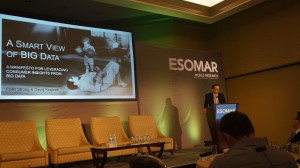
David Krajicek of GfK discussed the role of customer insights in the world of Big Data. Compared to market research, Big Data often provides a census instead of a sample, a flow of data instead of at fixed points in time, and unstructured data. It facilitates customer targeting and offers a theoretical deductive analysis. Big Data provides the “What?”, market research the “How?” and experimental approaches the “Why?” One view is that Big Data dispenses of the need to use traditional market research. Alternatively, a “Smart Data” approach marries the two, leveraging proprietary sources — proprietary brand data, aggregated brand data, and third-party collected data — and open data sources — social media, cultural artifacts, and government data. Survey tools integrated with Big Data help join the dots.
Where the Magic Happens – The integration of big data into traditional market research
Gregory Mishkin of Market Strategies International built on this point, discussing a hybrid project framework integrating Big Data and traditional research. This framework projects the attitudes expressed by survey samples onto the overall database, providing targeting based on attitudes and creating actionable frameworks. Market Strategies starts with an initial survey of a sample, applies a loyalty segmentation, analyzes the Big Data for respondents by segment and develops behavior profiles that are then applied to the entire database. Segmented-tagged customers are then invited to a survey to validate the applied segmentation. Once it is valid, the goal turns to encourage advocacy by doing product development and remediation research using a qualitative study with the segment. The next step is to validate the qualitative with an experimental design, applying the changed loyalty program and then redoing the survey to see if there has been an improvement in loyalty advocacy. If there is, then rollout the program to the entire loyalty segment.
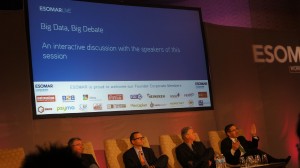 Don Hodson of AT&T Mobility provided a case study: customers can’t recall and report in surveys all interactions with AT&T, so the company uses a dedicated panel that also aggregates data across every customer touchpoint — retail, marketing, warranty replacement, call centers, chat on line, usage data, network performance, billing, profile and other data sources. This behavioral data is critical for understanding what drives satisfaction. “We survey thousands to gain insights into millions.”
Don Hodson of AT&T Mobility provided a case study: customers can’t recall and report in surveys all interactions with AT&T, so the company uses a dedicated panel that also aggregates data across every customer touchpoint — retail, marketing, warranty replacement, call centers, chat on line, usage data, network performance, billing, profile and other data sources. This behavioral data is critical for understanding what drives satisfaction. “We survey thousands to gain insights into millions.”
The ability to integrate consumer attitudinal and behavior data may not be magic, but it is powerful. As Gregory said, “Big Data is a Big Deal.”


